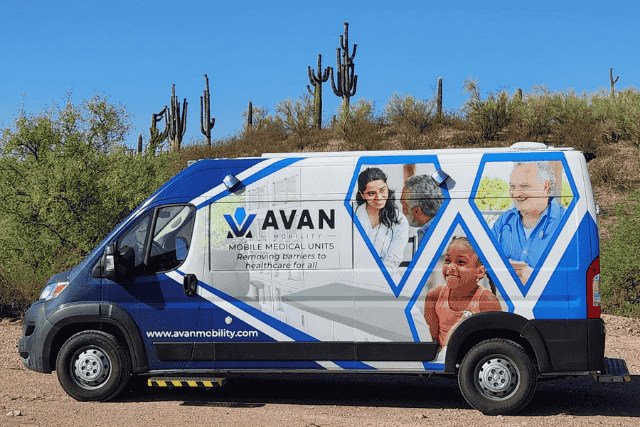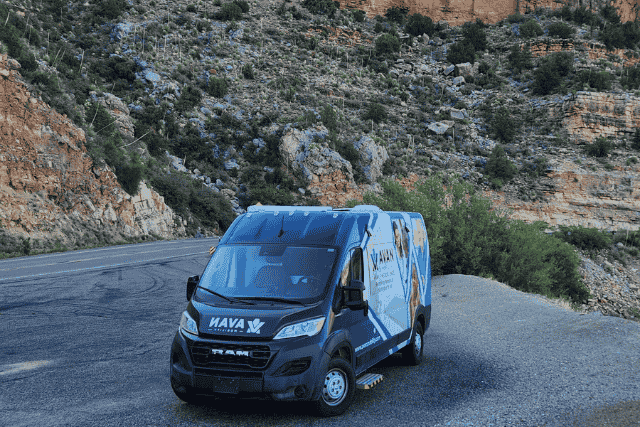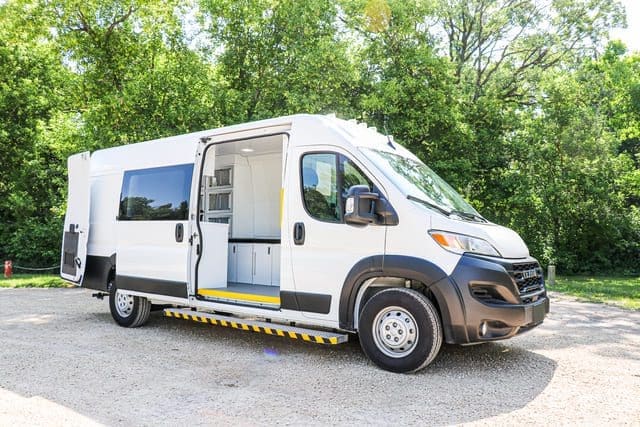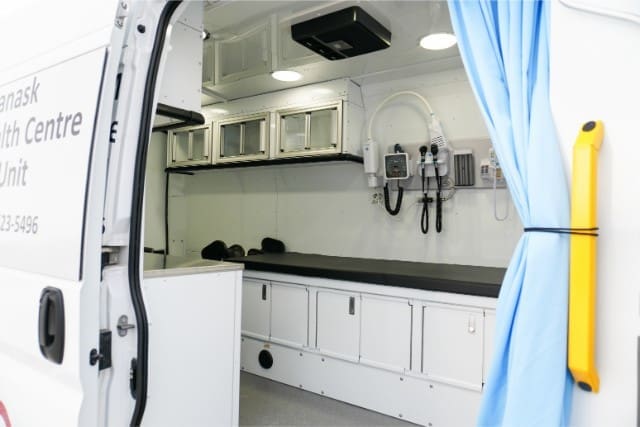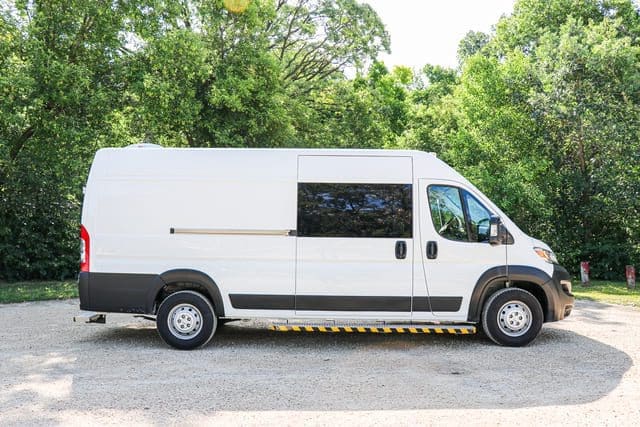Did you know: In 2023, fentanyl was involved in 65% of overdose deaths in New Mexico, and the state had one of the highest overdose rates in the country at 50.3 per 100,000 people. If you run a healthcare program or nonprofit in rural areas like Taos, Las Cruces, or Gallup, you probably feel stuck. People are driving hours just to get help, medication-assisted treatment is hard to find, and opioid use disorder keeps rising. Every day without action means more risk and more lives affected. It’s stressful, and you know it.
At AVAN Mobility, we’ve been helping teams like yours and CalOptima for over 10 years. We have Ford QVM and Stellantis QPro certifications, and we design mobile medical units that reduce barriers to care. We also know there are other manufacturers, so we want to give you clear, unbiased info to make the best choice for your community.
In this article, you’ll learn how mobile medical units can help fight the overdose crisis in rural New Mexico.
We’ll cover:
- The main challenges rural communities face
- How mobile medical units fill gaps in care
- Ways to deliver medication-assisted treatment directly to patients
Top 5 challenges rural New Mexico communities face with the overdose crisis
Rural New Mexico faces some tough problems with the overdose crisis. Small towns, desert areas, and tribal communities often don’t have the help people need. You probably see it yourself: People driving hours for treatment, families struggling, and local clinics being overworked. These challenges make it harder to save lives and support those who suffer from opioid addiction
1. Limited access to treatment and clinics
Distance: In many parts of rural New Mexico, like Mora County or around Gallup, the closest clinic can be 50 miles or more away. That’s a long drive for anyone, especially someone dealing with opioid use disorder.
Few specialists: Small towns often have very few doctors trained in medication-assisted treatment. People may have to wait weeks for an appointment or give up entirely.
Transportation problems: Public transit is almost non-existent in many rural areas. Without a car, patients can miss appointments or run out of medicine.
Impact on communities: When treatment is hard to get, overdoses rise, families suffer, and emergency services get overwhelmed. Rural areas can feel forgotten, and it’s easy to understand why people feel stuck.
Stress on families: Loved ones often carry the burden of care, trying to help with few resources. This adds emotional strain and leaves communities overworked.
2. Stigma and fear of seeking help
In rural New Mexico, the stigma surrounding addiction is a heavy burden. People often feel ashamed or afraid to ask for help. This fear keeps many from seeking the treatment they need.
Why it matters:
- Isolation: Small communities can make people feel like everyone knows their business. This makes it harder to reach out for help.
- Cultural barriers: In some areas, traditional views may not support seeking treatment for opioid use disorder. This can discourage individuals from pursuing necessary care.
- Lack of privacy: Without confidential services, people worry about judgment from family, friends, or neighbors.
The impact:
- Untreated addiction: People continue to struggle without proper care, leading to higher overdose rates.
- Family strain: Loved ones bear the emotional and financial costs of untreated addiction.
- Community health risks: Unaddressed addiction can lead to increased crime and emergency situations, straining local resources.
In Rio Arriba County, a region grappling with the overdose crisis, the stigma surrounding addiction has been a big barrier. Despite efforts to provide treatment, many individuals hesitate to seek help due to fear of judgment and social repercussions. This hesitancy contributes to the ongoing challenges in addressing the crisis effectively.
3. Lack of mental health support
In many rural parts of New Mexico, people struggling with opioid use disorder also face mental health challenges. The problem is, mental health services are hard to find.
Here’s what that looks like:
- Few counselors or therapists: Small towns like Taos or Raton might have only one or two mental health providers for the whole county.
- Long waits: Even if someone finds a therapist, appointments can be weeks away.
- High stress: Without support, people may feel hopeless or alone, which can make addiction worse.
How does this relate to the overdose crisis?
- Mental health struggles and opioid use often go hand-in-hand. If one isn’t treated, the other gets worse.
- Families feel the strain too. They may try to help on their own, but they usually don’t have the training or resources.
Each year in New Mexico, 414,000 adults, or about 1 in 5, experience a mental-health condition, and among them, roughly 101,000 live with a serious mental illness that disrupts daily life. Even more alarming, 90,000 adults, 1 in 20, report having serious thoughts of suicide annually.
For young people, the crisis is just as stark: 40,000 adolescents ages 12–17 experience a major depressive episode, and 22,000 have serious suicidal thoughts every year. These numbers underscore the scale of the challenge outlined by NAMI New Mexico.
4. Limited education and awareness about treatment options
Another big problem in rural New Mexico is that many people don’t know what help is available for opioid use disorder. Without the right information, even those who want help can feel lost.
Here’s what happens:
- Not knowing about medication-assisted treatment: Some people haven’t heard that treatments like buprenorphine or methadone exist.
- Misunderstandings about treatment: Others think treatment is too hard, unsafe, or only for “other people.”
- Few community programs: Small towns often don’t have outreach programs to educate residents about overdose risks or treatment options.
How does a lack of education affect people dealing with overdose crises?
- People might try to quit on their own and fail, increasing overdose risk.
- Families may push loved ones toward unsafe methods because they don’t know about professional care.
- Communities miss chances to prevent overdoses before they happen.
In New Mexico, research has shown that when opioid treatment program clients receive overdose education and take-home naloxone, many go on to reverse overdoses in their communities. The data is clear: Education paired with access saves lives. Without it, families and providers lose one of the most immediate and effective chances to stop an overdose in progress.
5. Emergency services are overwhelmed
Rural New Mexico often has fewer emergency responders and medical staff. When overdoses happen, local services get burnt out.
Here’s what that looks like:
- Long response times: In areas like San Miguel County, it can take 20–30 minutes or more for an ambulance to arrive. Every minute counts in an overdose situation.
- Limited staff: Small towns might have only a handful of paramedics and nurses, and they often juggle multiple emergencies at once.
- Burnout: First responders see overdoses regularly, which can be stressful and exhausting over time.
Why it matters:
- Delays in help can cost lives. Fentanyl and other opioids can act fast, and getting treatment late can be deadly.
- Families may panic, unsure where to turn for immediate support.
- Communities feel the strain as resources are used up quickly, leaving gaps for other medical needs.
Ambulance deserts grip rural New Mexico, and nearly 120,000 residents live in areas where emergency response services are absent or severely delayed, compounding the risk that overdoses will turn fatal.
How can mobile medical units ease the overdose crisis in New Mexico?
Organizations like yours can use mobile medical units to bring care directly to people in rural communities. They make it easier to access mental health support, medication assisted treatment, and follow-ups. These units reduce travel, stress, and stigma, giving patients a safe place to get help. Let’s look at how each type of mobile unit can help.
Mobile Counseling Van

Mental health support is key when addressing opioid use disorder. The Mobile Counseling Van gives your team a safe, comfortable space to help people talk about their struggles.
What it offers:
- Comfortable space: Couches, passenger seating, and a desk make it feel more like a living room than a clinic.
- Privacy and safety: Patients can speak freely without fear of being judged or watched.
- Tech and connectivity: Wi-fi and a sound system allow for private sessions and online resources.
- Welcoming design: Pleasant flooring, optional skylight, and interior/exterior decals make the van approachable and calming.
Why it works:
- People can open up in a relaxed setting, which makes mental health and addiction support more effective.
- Regular follow-ups are easier because the van can travel to where patients live.
- It helps reduce stress and stigma, making treatment feel less scary and more human.
Mobile Outreach Van
The Mobile Outreach Van is super flexible and can be used for lots of different services. It’s perfect for rural New Mexico communities that need more than one type of care in one spot.
What it offers:
- Behavioral health: Support for people dealing with addiction or other behavioral health challenges.
- Primary care: Basic medical checkups and health monitoring.
- Harm reduction: Tools and resources to reduce the risks of opioid use.
- Referral services: Connects patients to clinics, specialists, or other programs in the area.
- Overdose prevention: Education, supplies, and early intervention support.
- Mental health and addictions counseling: Safe, private space to talk through struggles and treatment options.
Why it works:
- Versatility: You can use it for one program or combine multiple services in a single visit.
- Reach: Brings care directly to communities that might otherwise wait weeks for treatment.
- Efficiency: Let your team provide different types of support without needing multiple locations.
This van is like a Swiss Army knife for healthcare on the go. It adapts to your program, giving communities the services they need, when and where they need them.
Mobile Clinic Van
The Mobile Clinic Van is perfect for providing hands-on medical support to people dealing with opioid addiction. It gives your team a professional, organized space to offer care right in the community.
What it offers:
- Exam bed: For checkups, health monitoring, and basic medical assessments.
- Floor-to-ceiling cabinetry: Stores files, supplies, and medications in a safe, organized way.
- Office desk and chair: Keeps track of patient data, appointments, and follow-ups.
- Accessibility options: Rear lift or side ramp makes it easy for anyone to enter the van safely.
Why it works:
- On-the-spot care: Patients can get checkups and basic treatment without traveling long distances.
- Organized workflow: Everything your team needs is inside, from medical tools to patient records.
- Safe and private: Patients feel comfortable receiving care in a secure, professional environment.
- Accessible design: Helps people with mobility challenges get the care they need without hassle.
This van turns your team into a fully equipped clinic on wheels. It’s designed to bring medical care directly to those who need it most, making treatment easier, faster, and more personal.
Mobile Overdose Prevention Van
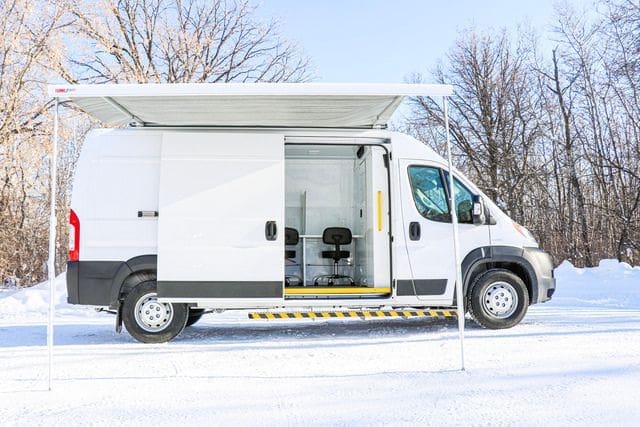
The Mobile Overdose Prevention Van focuses on safe consumption and keeping people alive. It’s built to give patients privacy and reduce stigma while connecting them to care.
What it offers:
- Individual pods: Private spaces where people can use safely and comfortably.
- Overdose prevention: Monitored environment to respond quickly if someone is in danger.
- Reduce public drug use: Keeps consumption off streets, parks, and other public spaces.
- Connections to care: Staff can link clients to medication-assisted treatment, counseling, and other health services.
Why it works:
- Privacy: People are more likely to seek help when they feel safe and not judged.
- Save lives: Immediate support can prevent fatal overdoses.
- Build trust: Clients who use the van often start other treatment programs and follow-up care.
- Support communities: Reduces the public health risks that come from unmonitored drug use.
This van gives your team a safe, controlled space to intervene before it’s too late. It’s all about keeping people alive, reducing harm, and connecting them to the care they need in a respectful way.
Use settlement funds to bring care closer
The overdose crisis in rural New Mexico isn’t slowing down, and communities need real solutions now. One option many programs don’t think about is using opioid settlement funding to put mobile medical vans on the road. These funds were set aside to fight the opioid crisis, and vans are one way to bring care right to the people who need it.
For towns like Taos, Gallup, or Las Cruces, a mobile unit can mean:
- Help faster: Get to people in remote areas before an overdose turns deadly.
- More support: Offer treatment, counseling, and follow-ups in one safe place.
- Less stigma: Meet people where they are, privately and with respect.
You don’t have to face this crisis alone. Settlement funds are already available, and putting them toward mobile medical vans is a simple, direct way to protect lives in rural New Mexico.
Ready to ease the overdose crisis in New Mexico with a mobile medical unit
You came here because you care about the overdose crisis in rural New Mexico and want to find practical ways to help. After reading this, you’ve seen how mobile medical units can bring care directly to communities, tackle the biggest challenges, and connect people to life-saving treatment.
Here’s a quick recap of what you learned:
- The top 5 challenges rural communities face in the overdose crisis
- Different mobile medical units and how they help with counseling, prevention, and medical care
- Opioid settlement funding can help cover the cost of these vehicles
At AVAN Mobility, we’ve been building mobile medical units for over 10 years, working with organizations just like yours all over the U.S. Our vehicles are designed around the people you serve, helping you deliver care safely, efficiently, and compassionately. We’re proud to be leaders in the industry and to help your team make a real impact in communities that need it most. If you have questions, click below to chat with one of our mobility experts.
Not ready to talk yet? That’s okay! Here are a few articles to guide you further:
- How much does a mobile medical unit cost in the U.S.? Learn what it takes to budget for a mobile unit.
- The pros and cons of leasing vs. buying a mobile medical van: Learn all about the drawbacks of purchasing and leasing a mobile medical unit.
- A guide on securing grants for mobile health clinics in the U.S.: Find funding options that can help make a mobile unit possible.
